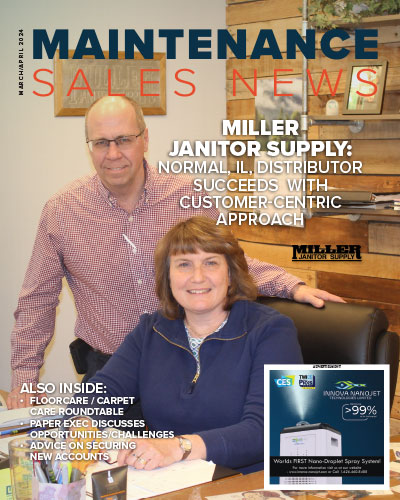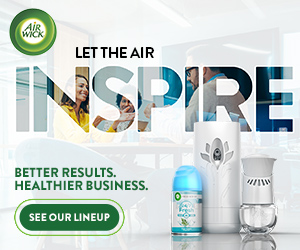Mastering Restroom Odor Control: 4 Steps To A Fresher, Happier Space
By John Schauff, Director of Government Services & Training, Spartan Chemical Company
Restrooms have always held a unique place in the realm of facility management. Often overlooked, they serve as a barometer of an establishment’s attention to detail, cleanliness, and overall commitment to user experiences in their spaces. A well-maintained restroom not only leaves a positive impression but can also translate to an increased sense of trust in an organization, fair or not. At the crux of this experience is a challenge known all too well: the odor. Contrary to the approach many take, the solution is not simply masking these offensive odors but embracing a comprehensive, multi-faceted approach spanning from prevention to on-demand solutions. Following these steps can help make sure the restroom in your facility doesn’t smell like, well, a restroom.
- Proactive, Routine Maintenance — Tackling bathroom odors goes beyond superficial measures; it demands a holistic approach that starts at the root and incorporates consistent, routine daily care. At the core is understanding that odors stem from bacteria and the organic material they consume. To combat this, it’s essential to create a bathroom environment where bacteria struggle to thrive. In addition to those steps and the obvious removal of larger, more visible material through sweeping and mopping, daily cleaning with disinfectants is critical. These disinfectants serve multiple purposes —they not only neutralize existing bacteria but also strip away the organic materials these microorganisms feed upon. Routine preventive measures like these make the space feel and smell fresh and reduce the need for frequent deep cleans, leading to long-term cost savings. This daily ritual takes time, training and commitment, and many facilities benefit from using facility management software to ensure these regular cleanings are done to the facility’s standards. The result, however, is worth it: a clean environment that remains fresh and inviting every day.
- Going Beyond the Routine with Biological Guardians — Routine maintenance, no matter how rigorous, has its limitations. Bacterial populations can be resilient, finding new organic materials to feed upon and multiply. In this situation, biological digesters offer a unique solution. These are advanced formulations that continue working long after the cleaning crew has done their job. Remaining on surfaces after application, they act as persistent guards, consuming organic waste and depriving bacteria of the sustenance they need to survive and multiply. Over time, this continuous action results in surfaces that are not just clean but also largely resistant to the resurgence of foul odors. It’s a futuristic approach to a timeless problem, ensuring that restrooms remain pleasant even in the face of unexpected challenges.
- On-Demand Responses for Unpredictable Needs — In the dynamic environment of a restroom, there will always be unforeseen challenges or problems that need immediate resolution. Maybe a large event leads to an unexpected surge in users, or perhaps an unforeseen maintenance issue briefly disrupts the cleaning schedule. When this happens, passive odor control solutions can be beneficial. Incorporating these specialized tools into your approach can provide huge benefits:
- Urinal and Commode Mats: Placed beneath urinals, these mats help prevent slip hazards from splashbacks and also contain odor-neutralizing agents to maintain freshness.
- Urinal Screens: Urinal screens not only prevent blockages but are often infused with fragrances or odor neutralizers to reduce unpleasant smells. Many urinal screens will also help reduce splashback, reducing the need for more frequent cleanups.
- Commode Clips: Attached to toilet bowls, these discreet clips release fresh scents, ensuring a more pleasant user experience each time the toilet is used. Commode clips help address odors at the source, ultimately improving restroom sanitation perception.
- Passive Air Fresheners: These are non-aerosol fresheners that continuously release a scent to maintain a pleasant atmosphere. They work quietly in the background, without requiring manual intervention, eliminating the need for messy gels or liquids.
Though these tools are not the primary line of defense, they provide persistent odor counteractant in between daily cleanings. They ensure that, even in a pinch, the restroom environment remains welcoming and fresh.
- ‘Common Scents’ — In addition to the strategies mentioned earlier that focus on addressing restroom odors and unexpected challenges, there is another aspect that greatly enhances the user experience: consistency in fragrance. Imagine walking into a restroom and being greeted by a mix of smells all competing for attention. This is where the concept of “common scents” comes into play. By selecting and using products with the same, or similar fragrances, you can create a consistent, more pleasant experience for your visitors. Choosing fragrances sets a mood to make the environment more inviting and demonstrates attention to detail. Therefore, when selecting products such as cleaning agents, disinfectants, air fresheners, or passive odor control items considering their fragrance compatibility can make a huge difference.
In conclusion, effective restroom odor control is both an art and a science. It requires an intricate balance of preventive measures, rigorous routines, and innovative solutions. For organizations and facility managers, it’s more than just a task on a checklist — it’s a commitment to the users and a testament to a dedication to excellence. In embracing a comprehensive approach, you don’t just enhance the user experience, you raise the bar for what a restroom can and should be.
John Schauff has over 32 years of industry experience and 30 years with Spartan Chemical Company, Inc. He has held several positions with Spartan including Regional Manager (1991-2000), Bioaugmentation Manager (2000-2010), Director – Government Services Team (2005-Present), and Director of Training (2010-Present). A Drake University graduate, Schauff has written articles for numerous trade and government publications and is frequently a guest speaker for related forums.
At Spartan Chemical Company, we make clean simple®. We are a recognized leader in cleaning and sanitation solutions for the industrial and institutional market. As a proud U.S. employer, Spartan formulates and manufactures high quality products from our state-of-the-art facility in Maumee, OH, and sells both domestically and internationally through a select network of distribution. Spartan’s products and services are used in building service contractor, education, food service and processing, health care, industrial, lodging/hospitality, and vehicle care markets. Visit spartanchemical.com.








